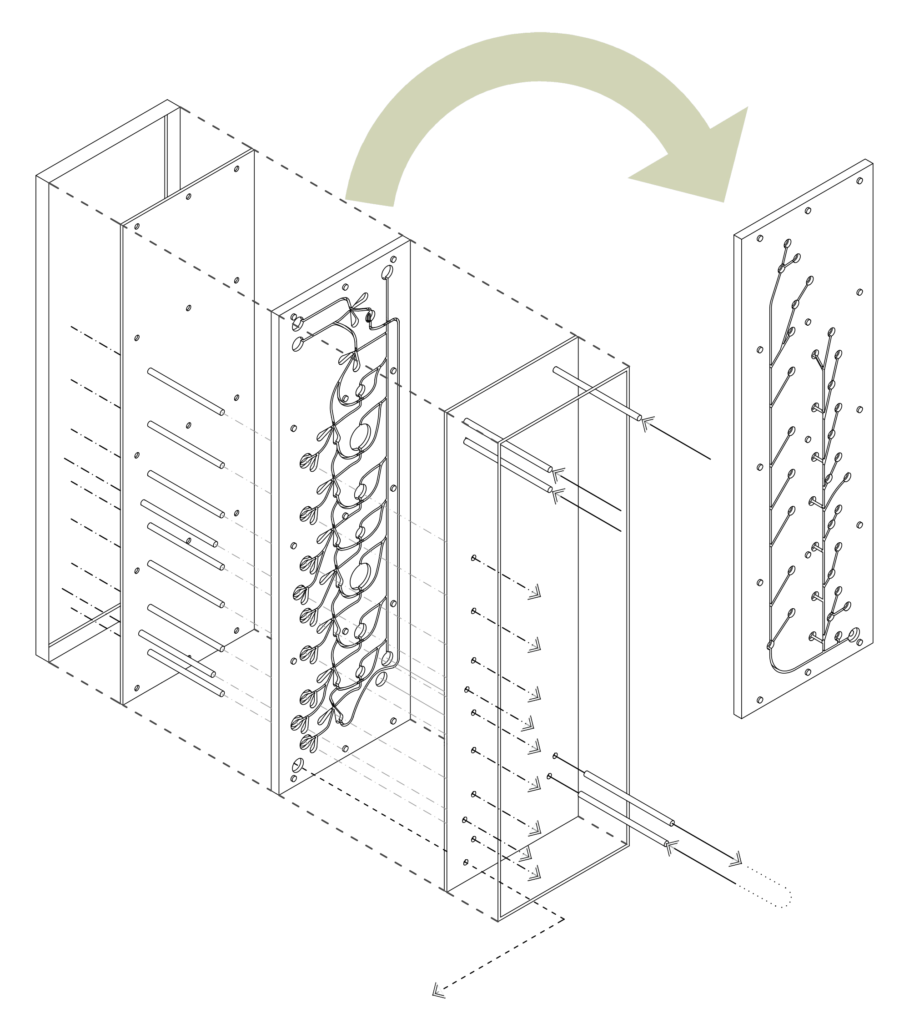HYDRAULIC SURFACE SENSING AND AUTOMATION SYSTEM

This simple analog solution is designed to control and time better the activities of the growing system, but can be used for any sort of automations in the living space. By embedding the sensing functions within the space’s surfaces, the controls of the room become hidden to the eye and thus allow for a very high-tech and high-performance space to be as invisible and easy to use as can be. The normal activities and motion of humans in the room is what controls and offsets everything that is automated inside.
The two circuits

In general terms, the system consists of two interlinked hydraulic circuits, a sensing circuit (solid line) that runs through the space’s surfaces and the acting circuit (dashed line) which takes the fluid to the automated elements of the house causing them to move or activate depending on the program requirements.
The program board (in the picture below to the right) is the part that contains the program to execute and which connects the two circuits with specific relay-like valves so in essence we have a simple automation system without electricity or information movement, all done with simple hydraulics. Here we have a simple curtain or blind opening solution which operates according to human’s presence in the room.
Surface sensing

The embedded circuitry works within the space’s surfaces and requires them to possess some softness, which makes the case for more organic and ergonomic space designs. An additional feature is the thermal balancing function of such a circuit being present and in use at all times.
The most important feature of course is the immediacy and simplicity of use and a visual clarity of space with no clutter of buttons, cables or screens, which promotes mental health and a feeling of relief from stress.
Another extra is the absolute privacy of such a system: as there are no information circuits there is no chance of it being corrupted or exploited for nefarious reasons. Less vibrations and exposure to electric fields is another bonus, too.
Fluidic logic and programming

A sample circuit board shown here in detail in essence is in charge of conducting the water through different pathways embedded in the board, making it an analog embodiment of a simple logic program. The circuitry can be hidden or exposed as it can be quite decorative as a design object.
The sensing circuit passes through the ridges and curves of the program opening and closing the opposing action circuits (perpendicular dashed lines) that give way to a sequence of actions which will be performed in the living space.

Example of use: the self-cleaning room
This is one of the cases where the combined design and automation can make for a space that provides more than just shelter or comfort. In this case, the embedded circuitry in the floor can detect the presence of people in the room, and after enough activity when the room becomes empty, the cleaning starts. Some basic hydraulic facilities embedded in the floors and walls allow for the cleaning to be performed without the need for human’s attention to the task, this way becoming a simple self-cleaning space with no high-tech features or maintenance costs. Everyting works as a simple cohesive living organism.